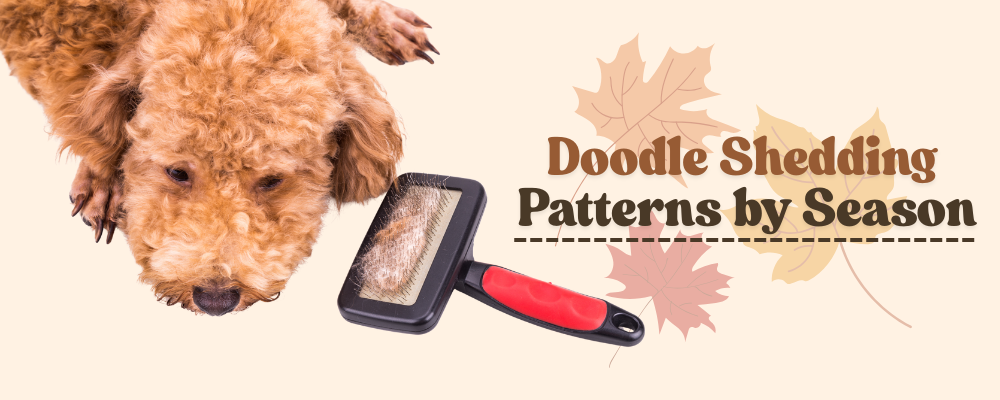
Doodle Shedding Patterns by Season: What to Expect Year-Round
|
|
Time to read 5 min
|
|
Time to read 5 min
Hey there, Doodle Owners! Elina here.
Finding clumps of hair around your home and wondering if your doodle's shedding follows a pattern?
Most doodle owners notice their pup's coat behaves differently throughout the year. Understanding these seasonal changes helps you know what's normal and when to adjust your grooming routine.
Doodles inherit coat characteristics from both poodle and other breed parents. This genetic combination creates varying shedding patterns that differ from traditional dog breeds.
Your doodle's specific mix influences how dramatically seasonal changes affect their coat.
Generation also matters.
F1 doodles often show more pronounced seasonal shedding than F1B or multigen doodles due to stronger influence from the non-poodle parent breed. However, individual dogs within the same generation can still vary significantly.
Spring brings the most noticeable shedding period for most doodles. Your dog's body responds to increasing daylight hours and warming temperatures by releasing their winter coat.
This process typically begins in late February or early March and continues through May.
During this time, you'll notice:
Expect daily hair removal during brushing to double or triple compared to winter months. Some doodles shed enough hair to fill a grocery bag over the course of the spring shedding period. This amount varies based on coat density and individual genetics.
The shedding should remain relatively even across your doodle's body. Patchy or excessive hair loss in specific areas warrants attention from your veterinarian.
Summer typically brings relief from heavy shedding. Most doodles maintain a lighter, more manageable coat during these months. Your daily brushing sessions will yield significantly less hair compared to spring.
Temperature regulation becomes the priority during summer months. Many doodles naturally thin their coat to stay cooler, but this happens gradually rather than through dramatic shedding episodes.
Indoor air conditioning can affect your doodle's natural coat cycle. Dogs living primarily indoors may not experience the same dramatic summer coat thinning as those spending more time outdoors.
Some doodles develop a slightly coarser texture during summer months. This temporary change helps protect their skin from increased sun exposure and typically reverses in fall.
Fall brings the second major shedding period as your doodle prepares for colder weather.
This shedding usually starts in September and continues through November, though timing varies by geographic location and individual dogs.
The fall shed typically involves:
October often represents peak fall shedding for most doodles. During this month, daily brushing becomes particularly important to prevent matting as the new undercoat grows in.
Unlike spring shedding, fall shedding often happens in waves. You might notice heavy shedding for a week, followed by a calmer period, then another intense shedding phase.
Winter typically brings the calmest shedding period for most doodles. Once the winter coat fully develops, shedding decreases significantly. Many owners notice dramatically less hair during daily brushing sessions.
The established winter coat provides insulation and temperature regulation without requiring frequent turnover. This stability makes winter an ideal time for longer grooming intervals.
Heated indoor environments can disrupt natural winter coat patterns. Doodles living in consistently warm indoor temperatures may continue light shedding throughout winter months.
Dry indoor air can also affect coat health during winter. Some doodles develop slightly more brittle hair that breaks rather than sheds naturally.
Several factors influence how dramatically your doodle experiences seasonal shedding:
Consistent brushing remains the most effective way to manage seasonal shedding. During peak periods, daily brushing prevents loose hair from accumulating in your home and reduces matting risk.
Increase brushing frequency during spring and fall shedding periods. What works during calm winter months may prove insufficient during active shedding seasons.
Bath frequency can also help during heavy shedding periods. A thorough bath loosens dead hair and makes brushing more effective. However, avoid over-bathing, which can dry out your doodle's skin.
Professional grooming appointments every 6-8 weeks help maintain coat health year-round. Groomers can remove undercoat buildup that regular brushing might miss.
Managing seasonal shedding becomes easier with the right tools.
A high-quality undercoat rake, such as the Safari Dog Undercoat Rake removes loose fur more effectively than standard brushes during peak shedding periods.
A specialized detangler spray simplifies grooming during heavy shedding seasons.
The Doodle Detangler Spray helps separate matted hair that often forms when loose undercoat mixes with the topcoat.
Furniture protection becomes important during shedding seasons. Washable furniture covers or lint rollers like the ChomChom Roller Pet Hair Remover, make cleanup more manageable.
Complete coat care becomes more efficient with multi-purpose products during peak shedding times.
The 5-in-1 Doodle Shampoo combines cleaning, conditioning, deodorizing, detangling, and moisturizing in one step. Maintaining coat health throughout seasonal transitions.
Understanding your doodle's seasonal shedding patterns helps you prepare for busier grooming periods and recognize what's normal for your individual dog.
Most doodles follow predictable spring and fall shedding cycles, with calmer periods during summer and winter months. Consistent grooming and appropriate tools make managing these natural cycles straightforward and stress-free.
What seasonal shedding patterns have you noticed with your doodle?
Comment below and share your experiences with other doodle owners!





